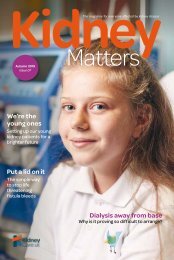Kidney Matters Issue 13 - Summer 2021
Kidney Matters is our free quarterly magazine for everyone affected by kidney disease. This issue includes features on music and mental heath, a transplant patient rediscovering a love of art to keep herself motivated, a teacher and CKD patient who helped anyone struggling with home-schooling their children during lockdown, medical articles about having a stent removed after a transplant, chronic kidney disease-mineral bone disease and how weight management can affect kidney patients following transplant. As well as this, the Kidney Kitchen explains how tomatoes can be safely included in your diet and shares a simple and tasty tomato pasta recipe especially prepared for kidney patients.
Kidney Matters is our free quarterly magazine for everyone affected by kidney disease.
This issue includes features on music and mental heath, a transplant patient rediscovering a love of art to keep herself motivated, a teacher and CKD patient who helped anyone struggling with home-schooling their children during lockdown, medical articles about having a stent removed after a transplant, chronic kidney disease-mineral bone disease and how weight management can affect kidney patients following transplant.
As well as this, the Kidney Kitchen explains how tomatoes can be safely included in your diet and shares a simple and tasty tomato pasta recipe especially prepared for kidney patients.
Create successful ePaper yourself
Turn your PDF publications into a flip-book with our unique Google optimized e-Paper software.
22
I feel good from my head,TOMATOES!
People with chronic kidney disease (CKD) are often concerned about eating tomatoes
if they have been advised by their renal dietitian to follow a low potassium diet .
However, in the right amount and served with the right foods, tomatoes can still be
enjoyed safely.
One of the main aims of the Kidney Kitchen is to give you
as much variety as possible and that means including
tomatoes in some of our recipes - but only when
combined with low potassium ingredients. The overall
potassium content of the Kidney Kitchen recipes has
all been carefully analysed to ensure that those marked
‘low potassium’ are suitable for people with CKD who
have been advised to follow a low potassium diet.
Finding the balance of low and high potassium foods can
be worrying when you have kidney disease. That often
means it is easier to simply avoid foods which are high in
potassium. However, many high potassium foods can be
included safely and will provide you with other essential
nutrients as well as enhancing your enjoyment of food.
One of the most common questions we are asked as
renal dietitians is whether people with CKD can eat
fresh tomatoes and whether it is ok to use tomatoes
in cooking. If you wish to include high potassium foods
such as tomatoes in your diet it is worth considering –
• How much of these foods you have (portion size)
• How often you have them (frequency)
• What form they’re in (tinned, pureed, juice, fresh)
• What you serve it with (accompaniments)
• We do recommend that you follow any specific
advice given by your renal dietitian
Portion size
Most people with CKD can safely include one medium
(80g) tomato daily (as a one of your 5 a day), perhaps
served with a cooked breakfast, lunch or salad. Canned
tomatoes, used in cooking are often divided into several
portions for the finished meal. A quarter of a medium
size can of chopped tomatoes provides roughly the
same amount of potassium as one tomato (100g).
Frequency
Many high potassium foods such as tomatoes can be
eaten in small amounts, depending on your bloods results.
You shouldn’t exceed more than one small portion per day
(i.e. don’t include in more than one meal per day). If you
often experience high potassium levels you may want to
limit this further (i.e. down to 1-3 times per week).
Tomato ingredients
It is worth noting that tomato juice and tomato puree
are often more concentrated than tomatoes or canned
tomatoes. Tomato puree is therefore used in much
smaller amounts than canned tomatoes, in our Kidney
Kitchen recipes. In addition to this we reduce or omit
other vegetables in these recipes to allow for the higher
potassium tomatoes. In general we advise not to drink
tomato juice if you follow a low potassium diet.
Accompaniments
Serving a tomato based meal with low potassium
accompaniments will help to keep the meal’s total
potassium content to a low level. Using bread, pasta or
rice rather than potato is one way of doing this. Being
‘potassium aware’ - knowing which other foods are high
in potassium - can help you to ensure that you can have
variety in your diet and help keep your potassium levels
safe by not having too many ‘high’ foods on one day.
Many different things can affect your blood potassium
level including your appetite, dialysis adequacy,
medication, blood glucose levels and bowel function.
We recommend you speak to your renal dietitian for
individualised advice based on your blood results.
Overall, the more you know about the foods that you
enjoy eating regularly, the more you are able to safely
include a wider variety of foods. We hope you are
enjoying the Kidney Kitchen recipes we have selected.
Article by Laura Kyte
Renal dietitian, Royal Devon
and Exeter NHS Trust and RNG
dietitian in the Kidney Kitchen
www.kidneycareuk.org

















